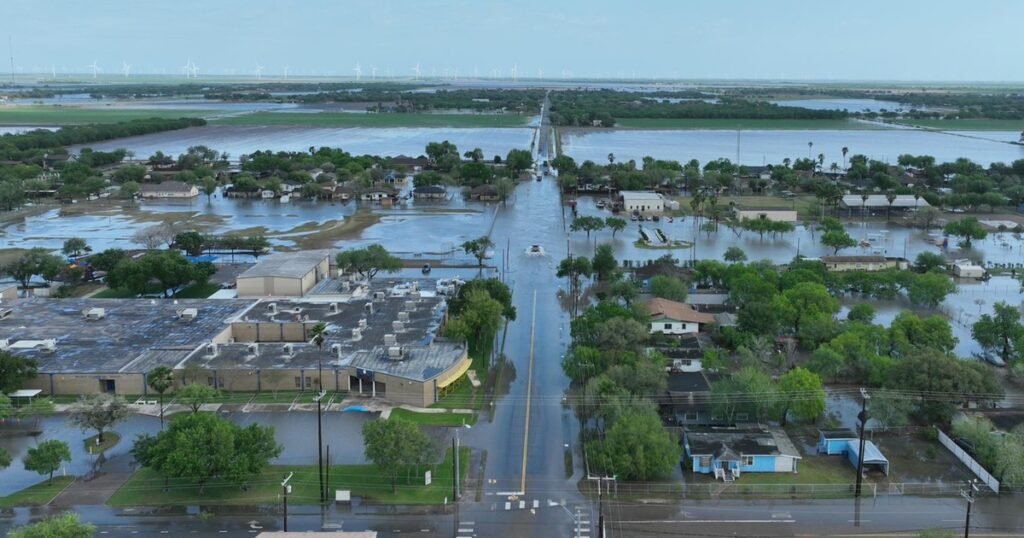Historic Flooding Devastates Rio Grande Valley: A Look at the Impact and Response
Unprecedented Weather Events in South Texas
In a shocking turn of events, the Rio Grande Valley experienced what experts are calling a 100-year flood as relentless rainstorm hit the region between March 26 and 28, 2025. This storm led to nearly 20 inches of rain, inundating neighborhoods and creating severe challenges for local authorities.
The Storm’s Impact: A Community in Crisis
Tragedy Strikes
At least six lives were tragically lost due to the severe flooding, with four individuals drowning in the Valley and Reynosa, Mexico. Two others perished when a house fire, reportedly sparked by a lightning strike, broke out during the storm’s fury. As of the following week, numerous neighborhoods remained submerged under water, necessitating extensive rescue operations for hundreds of residents trapped in their homes or vehicles.
Emergency Response Initiatives
The emergency management team in Hidalgo County, led by coordinator Rick Saldaña, quickly mobilized to address the ensuing crisis. As assessments of the damage were initiated, Texas Governor Greg Abbott issued a disaster declaration for several affected counties. The Federal Emergency Management Agency (FEMA) was also deployed to begin evaluating the scope of damage.
Economic Ramifications
Experts estimate that the total cost of recovery from this disaster could exceed $100 million, as detailed by the National Weather Service Brownsville. Saldaña emphasized the unpredictability of such storms and the necessity for improved rainfall forecasts.
"We were predicted to get no more than one to two inches of rain," he stated. "But the storm shifted dramatically, resulting in catastrophic rainfall."
A History of Severe Weather
Historically, the Rio Grande Valley has faced significant weather events. Saldaña recalled a major storm in 2018 that highlighted the difficulties of sudden storms, especially in the transitional months of March and April. Unlike hurricanes, which offer advanced warning, these storms can strike with little notice, complicating preparation efforts.
Infrastructure Challenges
Despite advancements in local infrastructure, including improvements to the drainage system, the relentless downpour outpaced these upgrades. Saldaña remarked, “It doesn’t matter how efficient your drainage system is; it couldn’t handle this volume of water.”
Meteorological Insights
The National Weather Service reported that, while storm predictions indicated heavy rain, the specific areas affected were miscalculated. Meteorologist Barry Goldsmith noted that high-altitude air currents typical of other regions contributed to an unexpected intensity, moving the storm toward the Valley at the last minute.
“The severe weather hit areas we were not prepared for," he acknowledged.
Damage Across Multiple Sectors
While residents and infrastructure suffered significant blows, local agriculture felt the effects most acutely. Many crops were destroyed due to the flooding, leading to considerable financial losses for farmers who had previously faced drought conditions.
Sid Miller, the Texas agriculture commissioner, highlighted the perilous situation, stating, "In addition to extensive damage to homes and infrastructure, the region faces significant agricultural and livestock losses."
A Silver Lining for Farmers?
Despite the extensive damage, there is a glimmer of hope. The Falcon International Reservoir, essential for local irrigation, received substantial rainfall, growing from 11.2% to 12.8% of its capacity. While this increase is marginal, it offers some prospects for future irrigation over the upcoming weeks.
“Every drop counts," remarked Sonny Hinojosa, a water advocate with the Hidalgo County Irrigation District. "But we’re still facing severe challenges."
Looking Ahead: Recovery and Resilience
As the community begins to rebuild, it is clear that resilience will be key to overcoming the aftermath of this disaster. Local officials and residents must work collaboratively to improve infrastructure and preparedness for future weather events.
Conclusion
This recent flooding disaster serves as a stark reminder of the volatility of weather patterns in South Texas. By fortifying drainage systems and enhancing emergency response protocols, the Rio Grande Valley can better prepare for unexpected storms that may arise in the future.
For residents seeking to stay informed, subscribing to local news outlets can provide essential updates on recovery efforts and community support initiatives.


